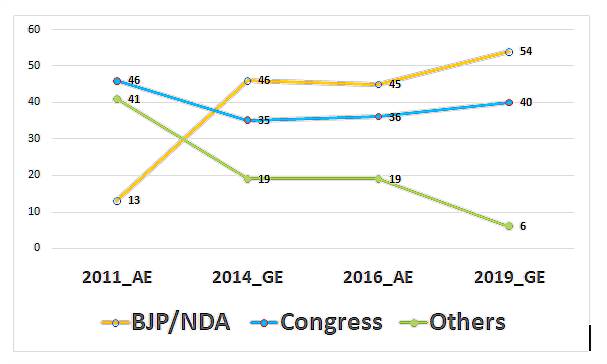
views
In East and North India, Assam is only state (among the major states with more than 100 Assembly seats) where the Congress is the main challenger to the BJP. As the voting for the first phase in Assam has begun, the state will test whether or not the BJP-led NDA can hold on to their dominance despite the protests against the Citizenship (Amendment) Act? Voting in Upper Assam region would be decisive as the BJP-led NDA has been continuously dominating each and every election here since 2014. If they fail to hold it here, they will face problems in winning another majority in the state.
The upper in Upper Assam
Upper Assam is the biggest among all the three major regions in the state, with 56 Assembly seats. The electorate in 47 of these constituencies is voting on Saturday, March 27, in the first phase. The electoral outcome in this region is crucial in determining the fate of the next government in many ways. First, this is the biggest region in Assam, accounting for nearly 44 per cent of the total Assembly seats in the state—whichever party has a decisive lead here would inch closer to forming the next government in the state. Second, this has been a stronghold of the ruling BJP since the last few elections, where the party (and its alliance partner/s) has not only increased its vote share but also widened the vote share gap with the main opposition party, the Congress (see chart below). Third, in pre-Covid Assam, this region saw a much intense protest, compared to rest of Assam, against the Citizenship (Amendment) Act or CAA. Many students and student unions had participated in protests; therefore, it would be interesting to see how people in this region vote.

Note: All figures are in percentage and rounded-off. The BJP contested alone in 2011 and 2014 while in 2016 and 2019 elections, it contested in alliance with the AGP in this region. Data Source: ECI
Before 2014, the BJP was a minor player here and the Asom Gana Parishad (AGP) had a wider support. However, it was the Congress that enjoyed electoral majority in this region, largely due to the traditional support from the ‘tea garden community’. However, the tea garden community’s support shifted to the BJP in 2014 after the party promised hike in daily wage and its inclusion in the Scheduled Tribes’ list.
In the 2014 Lok Sabha elections, the BJP got massive support in this region—its vote share stood at 46 per cent. This was a 33 percentage point jump, compared to the 13 per cent vote share in 2011 Assembly election. In the 2016 Assembly election, the BJP formed an alliance with the AGP and the Bodoland People’s Front (BPF) and, once again, received massive support—with 45 per cent votes. Meanwhile, during the same period, the Congress’ vote share dropped 10 percentage points from 46 per cent to 36 per cent, between 2011 and 2016 Assembly elections. In the 2019 Lok Sabha election, the Congress did improve its vote share by 4 percentage points—with 40 per cent vote share—it, however, was still 14 percentage points behind the BJP-led NDA in these 47 constituencies. The vote share gap between the NDA and the Congress has been increasing because the former has pulled the votes which were earlier going to smaller regional parties. This means, the BJP has turned the electoral fight in this region into a bipolar contest. However, in terms of seats won, the BJP has shown a complete dominance in this region.
Given the huge vote share gap between the ruling alliance and the Congress, it can be an uphill task for the latter to challenge the BJP-led NDA’s domination in the region. However, voices of discontent on the ground suggest things may not be easy for the BJP too. Although not visible on the surface, the memory of the CAA protests is still alive in the minds of students and youth.
Discontent Vs Development
Two post-graduate students in Dibrugarh University I spoke to are not happy with the government’s move on the CAA. They feel if “others” are allowed here, it would lead to further job scarcity. “Where will we go,” they ask. Both of them had voted for the BJP in 2016 and 2019 but, this time, they are not going to visit their polling booths in Jorhat and Tinsukia. Several others I spoke to have similar concerns about CAA. Even in the tea garden area, some people fear “outsiders” will come and “they may take our jobs because they (outsiders) can work even below the minimum wages”.
The concern regarding the CAA in Upper Assam is palpable; however, it has not becoming a major electoral issue despite the Congress and other opposition parties pushing it hard. Why? There are two reasons. First, the state government has consistently focused on road construction work. “Rasta bana (road built)” is something which can be heard from almost every quarter. Second, the direct cash transfer under different schemes has also helped. Unlike the old Congress system in the state, where the beneficiaries would have to depend on the local (sardar) party leader and their supporters to get the benefits of any scheme, the direct cash transfers have reduced the dependency on local leaders and the energy people had to spend to avail the benefits. This is not to suggest that the importance of local leader has reduced; however, the nature of dependence has changed. The claim of development has put a blanket on the discontent among people over CAA, at least in the popular election debate.
No clear alternative
The leaders of the Congress, the Assam Jatiya Parishad (AJP) and Raijor Dal have been talking about CAA but this has not motivated the youth enough to vote for them. The young are in a dilemma this time—many feel that the AJP and the Raijor Dal, which participated in the CAA protests, may not be strong enough to replace the BJP-led NDA. The two parties could get some seats but are unlikely to get a majority.
Among the youth, the Congress is still facing the tag of a ‘corrupt party’. The Congress has entered into an alliance with Badruddin Ajmal’s All India United Democratic Front (AIUDF), the BPF and the Left parties and, at least on paper, is putting up a strong challenge to the ruling BJP-led NDA. However, it is important to note that in Upper Assam (in first phase), almost every seat is being contested by the Congress. The party had increased its vote share in this region by 4 percentage points during last year’s Lok Sabha elections, from 36 per cent in 2016 Assembly election to 40 per cent in 2019, but if it wants to challenge the BJP’s dominance, it would need 4-5 per cent vote swing in its favour. Whether or not it can benefit from the discontent over CAA will be known only on May 2.
Read all the Latest News, Breaking News and Coronavirus News here



















Comments
0 comment